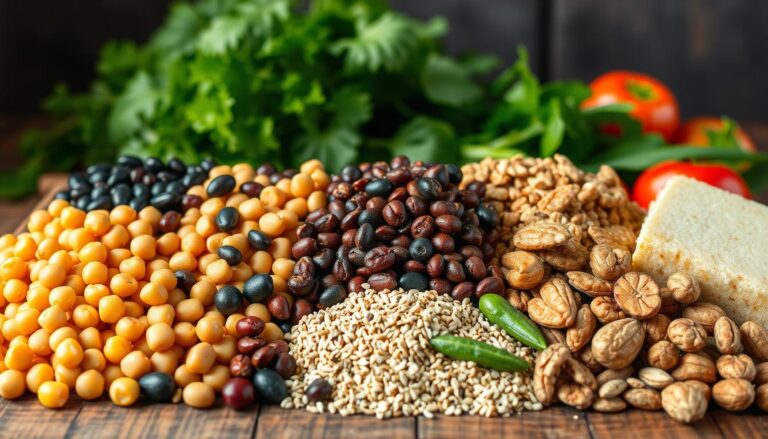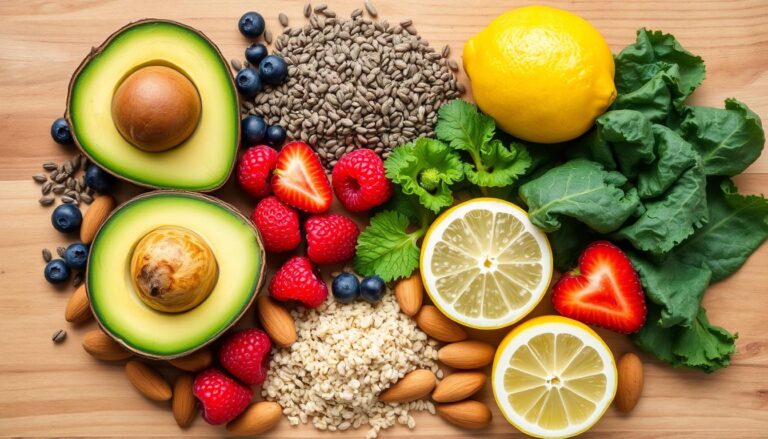Do you know what helps people live longer and avoid sickness? It’s what they eat! Foods with lots of antioxidants fight off harmful free radicals. This helps prevent damage and lowers the chance of getting sick1.
The U.S. Department of Agriculture (USDA) has found the top 20 foods rich in antioxidants. And guess what? They taste great too! Dark chocolate, blueberries, and leafy greens are on that list2.
Key Takeaways
- Antioxidants help neutralize free radicals and reduce the risk of chronic diseases.
- The USDA has identified the top 20 antioxidant-rich foods, including beans, berries, nuts, and leafy greens.
- Eating a mix of these antioxidant-rich foods is good for your health.
- You can increase antioxidant levels by cooking some foods a certain way, like tomatoes and garlic.
- Remember, it’s important to eat calorie-rich antioxidant foods like dark chocolate and pecans in moderation.
What Are Antioxidants?
Antioxidants are like shields for your body, protecting it from harmful molecules called free radicals3. These unstable molecules can build up over time. They cause oxidative stress, which can lead to heart disease, cancer, and other serious health issues3.
The Role of Antioxidants in Combating Free Radicals
Antioxidants fight these free radicals, keeping your cells and DNA safe3. You can find them in many plant-based foods, such as fruits, veggies, nuts, and spices3. Cooking can change the amount of antioxidants in food. Lycopene, for instance, is higher in cooked tomatoes than fresh ones3.
Foods like blueberries, blackberries, and cranberries are rich in antioxidants3. Nuts and grains are also great sources. Walnuts, pecans, and sunflower seeds are some of the best3.
Studies show that eating a mix of these foods is better than taking only supplements3. Aim for a wide variety of colorful fruits and veggies in your daily meals3.
Tea, coffee, dark chocolate, and even fruit juices can add to your antioxidants3. Remember, your body uses up vitamin C daily, so you need it each day3.

“Eating a diet rich in antioxidants can help neutralize these free radicals and reduce the risk of these chronic diseases.”3
| Antioxidant-Rich Foods | Antioxidant Benefits |
|---|---|
| Blueberries | May help prevent high levels of bad cholesterol and lower the risk of heart disease4. |
| Dark Chocolate | Has been linked to reducing blood pressure in 10 studies involving close to 300 participants4. |
| Artichokes | May help lower cholesterol levels and improve gut health. Steaming artichokes can increase the effectiveness of antioxidants by 15 times4. |
| Pecans | Can increase antioxidant levels in the blood and help lower oxidized LDL cholesterol4. |
| Strawberries | Anthocyanin supplements from strawberries have been shown to reduce LDL cholesterol levels4. |
Dark Chocolate: A Decadent Source of Antioxidants
Enjoying dark chocolate is a yummy, guilt-free treat. It’s packed with antioxidants, offering many health perks. Compared to milk chocolate, it has a lot more cocoa, leading to a powerful dose of good stuff.
The antioxidants in dark chocolate are mainly flavanols, known for fighting inflammation and heart disease risks6. They might also defend against some cancers and keep your brain sharp. Plus, they can lift your spirits by reducing stress and boosting happiness hormones7.
Aside from fighting disease, dark chocolate is rich in important minerals. It contains iron, magnesium, and more, supporting your health in various ways7. Plus, its fiber is great for your gut, helping good bacteria thrive8.
Dark chocolate also brings caffeine to the table. An almost four-ounce bar with 70%-85% cocoa has about 80 milligrams6. That’s less than coffee but more than soda.
Still, only eat dark chocolate in small amounts. It’s dense in calories and fats. You should stick to one or two ounces a day8. Be aware, some bars have metals like lead, which aren’t good for you in large amounts6.
Enjoying dark chocolate in moderation means enjoying its flavor and health perks687 to the fullest. So, go ahead and have a piece but not too much.

| Nutrient | Amount in 1/4 Cup (1.5 oz) of Dark Chocolate |
|---|---|
| Calories | 220 |
| Fat | 13 g |
| Carbohydrates | 24 g |
| Sugar | 18 g |
The American Heart Association says we should limit added sugar to 25-36 grams a day. So, enjoy dark chocolate wisely.
“Dark chocolate with high levels of cocoa solids (70% or more) contains flavanols, providing antioxidant and anti-inflammatory properties.”6
Using dark chocolate smartly in your diet lets you enjoy its deep flavor. It also brings great health benefits. So, snack on dark chocolate in a balanced way to get the best of both worlds.
Pecans: Nutty Powerhouses of Antioxidant Goodness
Pecans are native North American nuts and are now known as a superfood. They are loaded with antioxidants, making them great for adding to your diet9.
Moderation is Key for Calorie-Dense Pecans
One ounce of raw pecans has about 196 calories. It has 20.4 grams of fats, including the good kinds, like heart-healthy monounsaturated and polyunsaturated fats9. But, it’s key to eat them in moderation, especially if you watch your weight. Compared to other nuts, like walnuts and almonds, pecans have more calories9.
Don’t overlook pecans despite their calorie content. They offer 2.7 grams of fiber and 2.6 grams of protein in each ounce, which makes them a nutritious snack9. Also, the USDA ranks them in the top 20 antioxidant-rich foods. This is due to antioxidants such as vitamin E, ellagic acid, and flavonoids10.
Pecans have more health benefits beyond antioxidants. Eating them can improve heart health markers. In studies, people saw a drop in bad cholesterol levels shortly after eating pecans11. Plus, they have a low glycemic index, so they’re a good pick for those with diabetes9.

Despite being calorie-dense, pecans are a great choice due to their nutrients and antioxidants. Adding pecans to your diet, in small amounts, is a tasty way to up your antioxidant and well-being support91110.
Blueberries: Nature’s Antioxidant Superfood
Blueberries are a true gift from nature. They pack a powerhouse of nutrients and antioxidants. Despite being small, they are full of health benefits12. These berries are usually available from April to September in the U.S. Imports from South America let us enjoy them all year12.
While frozen blueberries have less vitamin C than fresh ones, they are still a great choice. They offer 25% of the daily recommended value for vitamin C and only 80 calories per cup. You get 1 gram of protein, less than 1 gram of fat, 22 grams of carbs, 4 grams of fiber, and 15 grams of sugar12.
Blueberries stand out because of their antioxidant content12. Wild blueberries have more anthocyanins than farmed ones12. These compounds offer various health benefits, like better brain health and a lower risk of heart disease and diabetes type 213.
Studies have found that blueberries’ antioxidants can slow down brain aging. They do this by fighting harmful free radicals, reducing inflammation, and changing certain gene functions12. Also, the anthocyanins in blueberries can help with heart health by reducing heart disease risks, lowering bad cholesterol, and decreasing blood pressure12.
But blueberries’ advantages go beyond their antioxidant content. They are full of dietary fiber, which is good for digestion12. Wild blueberries have roughly twice the fiber and calcium of farmed ones12. If you make blueberry tea with natural leaves, you’ll add more nutrition. This tea is rich in vitamin C, vitamin K, manganese, and potassium12. What’s more, blueberries are a great snack that’s under 100 calories per cup. So, they are a treat you can enjoy without guilt14.
Blueberries are great for boosting brain health, strengthening your heart, or enjoying a tasty, healthy snack121314. They truly are nature’s antioxidant superfood. Join the blueberry revolution and benefit from their amazing properties!
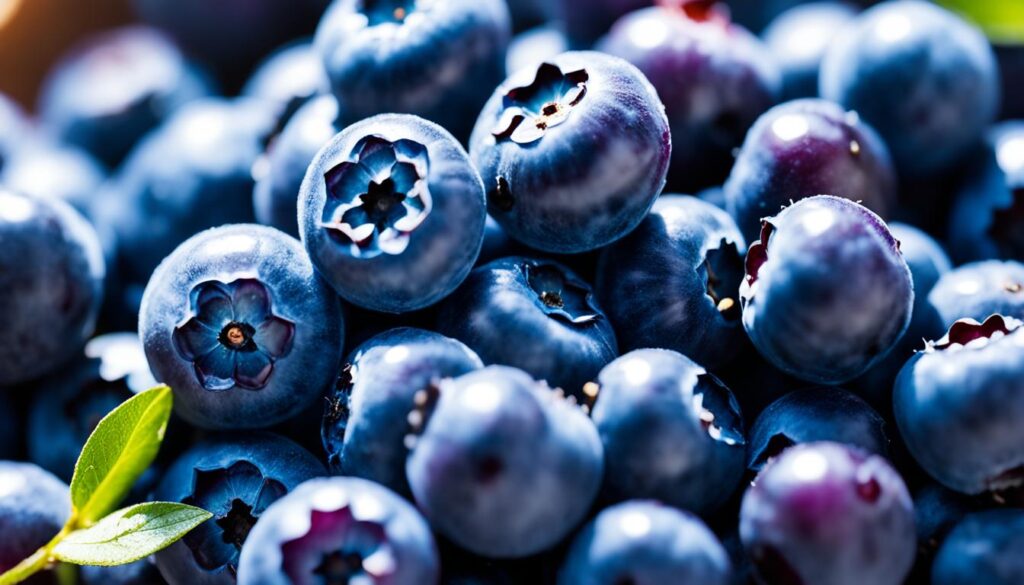
“Blueberries are the little blue dynamos of the fruit world, packing a mighty punch of antioxidants and nutrients in every bite.”
Antioxidant Foods: Berries Galore
Raspberries, Strawberries, and More
Berries like raspberries, strawberries, and blackberries are full of antioxidants. These include anthocyanins that lower risks of heart disease and cancer15. The U.S. Department of Agriculture ranks small red beans, wild blueberries, and red kidney beans as top antioxidants15. Strawberries, red delicious apples, and sweet cherries are also high on this list15.
Eating berries promotes health, though mostly seen in lab results15. Yet, they can still help your health a lot. Just one cup of strawberries gives you 150% of the daily vitamin C you need16.
Raspberries pack 8 grams of fiber in a cup, very nutritious16. Antioxidant-rich acai berries, elderberries, and gooseberries are great for varying your diet16.
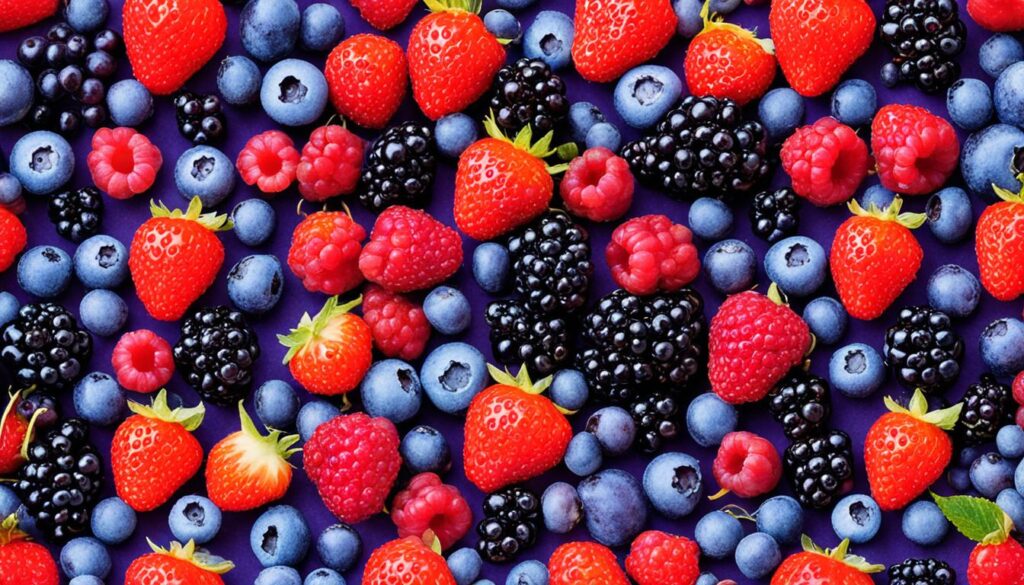
Focusing on antioxidants is good, but a well-rounded diet is key, say nutritionists15. Only picking a few foods might not help as much as eating a mix of fruits and vegetables. Include berries in your meals for a tasty and healthy boost17.
“Berries like strawberries, blueberries, raspberries, and blackberries are highlighted as antioxidant powerhouses in the text.”17
| Berry | Antioxidant Benefits |
|---|---|
| Raspberries | High in fiber and vitamin C16 |
| Strawberries | Rich in vitamin C, providing 150% of the daily recommendation16 |
| Blackberries | Packed with antioxidants and ranked among the top 10 foods with the highest antioxidant content15 |
| Acai Berries | Contain fiber, vitamin A, calcium, and carbohydrates16 |
| Elderberries | Rich in antioxidants and fiber16 |
| Gooseberries | Provide essential nutrients such as fiber, vitamin C, vitamin B5, and vitamin B616 |
Eating a variety of berries boosts your health. From raspberries to strawberries, they are a tasty and good way to get antioxidants171516.
Leafy Greens: Antioxidant Powerhouses
Leafy greens lead in the world of superfoods full of antioxidants18. They are rich in antioxidants such as lutein, zeaxanthin, and anthocyanins18. These nutrients help lower the risk of some cancers, heart disease, and protect eye health as we age.
Romaine lettuce has nine times more vitamin A than iceberg18. Kale alone meets 68% of your daily vitamin K needs in a cup18. Spinach is great for chlorophyll and vitamin K, and collard greens offer lots of fiber and essential minerals18.
Leafy greens have more to offer than just vitamins and minerals19. Eating a daily serving of two cups can make your brain 11 years younger in cognitive function19. Folate, phylloquinone, and lutein are key in this brain-protecting effect.
These greens are rich in cancer-fighting compounds, too19. Their carotenoids and folate stop early cancer by ensuring DNA repair19. Plus, dark leafy greens’ vitamin K helps keep bones strong and fights inflammation diseases19.
Being low in calories and high in nutrients, leafy greens are a top choice19. The USDA suggests adults eat two to three cups of veggies daily, with leafy greens key among them18. By adding these superfoods to your meals, you boost your health and energy levels.
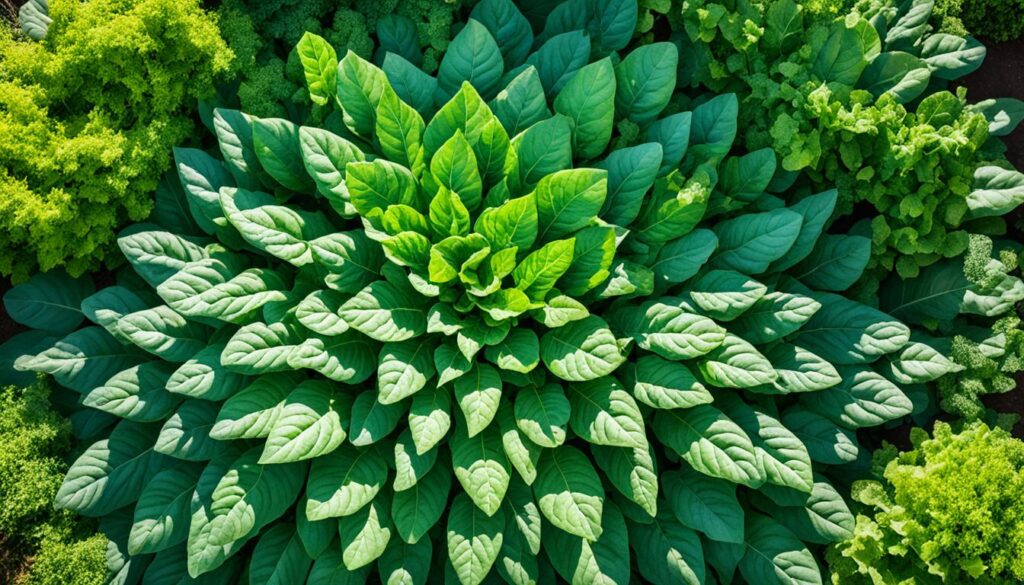
“Leafy greens are under 20 calories per cup, making them a low-calorie option packed with nutrients.”19
Want to feel more energetic and support your health? Eat plenty of leafy greens. They are a great source of antioxidants that your body will love.
Antioxidant Foods: Spices and Herbs
Spices and herbs do much more than add taste to our food. They’re full of antioxidants that help keep us healthy. Each one, like clove and cinnamon, has a special set of these antioxidants. They fight inflammation and lower our chances of getting sick.
Adding Flavor and Antioxidant Punch
Curcumin in turmeric is well known for fighting inflammation and being full of healthy antioxidants20. Turmeric might not be the top antioxidant spice, but it has 31% of the antioxidants in rosemary, which is ranked higher20. Ginger and garlic are also great. Ginger has gingerol, and garlic has allicin. They fight stress and inflammation21.
And the list goes on. Clove, peppermint, and many more are also rich in antioxidants20. When dried, these spices and herbs have even more antioxidants than when fresh20.
Using many spices and herbs makes your food tastier and healthier22. Their antioxidants work together against free radicals. They keep us healthy. So, they are a must in a diet full of antioxidants.
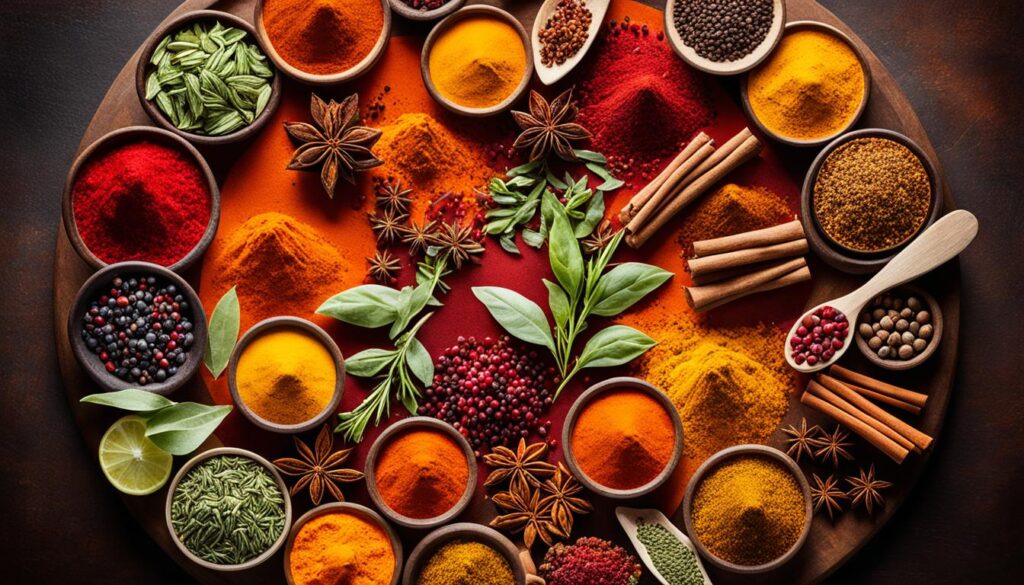
“Spices and herbs are among the most antioxidant-dense dietary sources described.”22
If you want warmth, try cinnamon. For a fresh taste, add oregano. Rosemary brings an earthy flavor. These spices and herbs not only make your dishes delicious but also bring many health benefits. Be adventurous in your cooking, and watch as your meals become both tasty and nutritious.
Beans: Fiber-Rich Antioxidant Wonders
Beans are a powerhouse of nutrition, full of vitamins, minerals, and antioxidants for your health23. They are high in fiber, with 12-16 grams in just one cup24. This fiber is great for your digestion and helps lower risks of heart disease, obesity, and diabetes24.
Beans also contain kaempferol, an antioxidant23. Kaempferol helps fight inflammation and may stop cancer growth. However, more research is needed to understand its full benefits23. Yet, eating beans boosts your health in many ways.
| Bean Variety | Calories | Protein (g) | Fiber (g) | Key Nutrients |
|---|---|---|---|---|
| Chickpeas (Garbanzo Beans) | 269 | 14.5 | 12.5 | Folate, Copper, Manganese, Iron |
| Lentils | 230 | 17.9 | 15.6 | Thiamine, Folate, Copper, Iron, Zinc |
| Peas | 134 | 8.58 | 8.8 | Thiamine, Folate, Manganese, Vitamin K |
| Kidney Beans | 225 | 15.3 | 13.1 | Thiamine, Folate, Copper, Manganese, Iron |
| Black Beans | 227 | 15.2 | 15 | Thiamine, Folate, Iron, Magnesium, Manganese |
| Soybeans | 296 | 31.3 | 10.3 | Riboflavin, Folate, Vitamin K, Iron, Manganese, Phosphorus |
| Pinto Beans | 245 | 15.4 | 15.4 | Thiamine, Folate |
Adding various beans to your meals boosts your health24. Pinto and black beans are rich in fiber. Soybeans offer great antioxidants23. This variety helps you live a healthier life25.
“Beans are a true superfood, packed with fiber, protein, and antioxidants that can have a profound impact on our health. Adding them to your meals is an easy way to boost your nutrient intake and support overall well-being.”
Choosing kidney, black, or lima beans is a win-win. Your meals get a fiber and antioxidant boost. Plus, they taste great! Your health will benefit.
Conclusion: Embracing a Rainbow of Antioxidant-Rich Foods
Incorporating many antioxidant-rich foods in your daily meals is super healthy. Think of the bright colors in fruits and veggies or the warm spices in nuts. These nutrient-dense foods are filled with good things. They fight bad free radicals, lower inflammation, and reduce risks of major diseases26.
Eating a variety of antioxidant-rich foods is like giving your body an armor. It’s packed with vitamins, minerals, and fiber. Plus, it helps fight aging and disease26. Berries, leafy greens, nuts, herbal teas, and dark chocolate – the world of plant-based nutrition is vast2728.
Ready to start your food adventure? Try adding more of these antioxidant-rich foods to what you eat. Watch how it affects your health. Embracing a variety of these foods will make you happier, healthier, and more alive272628.


